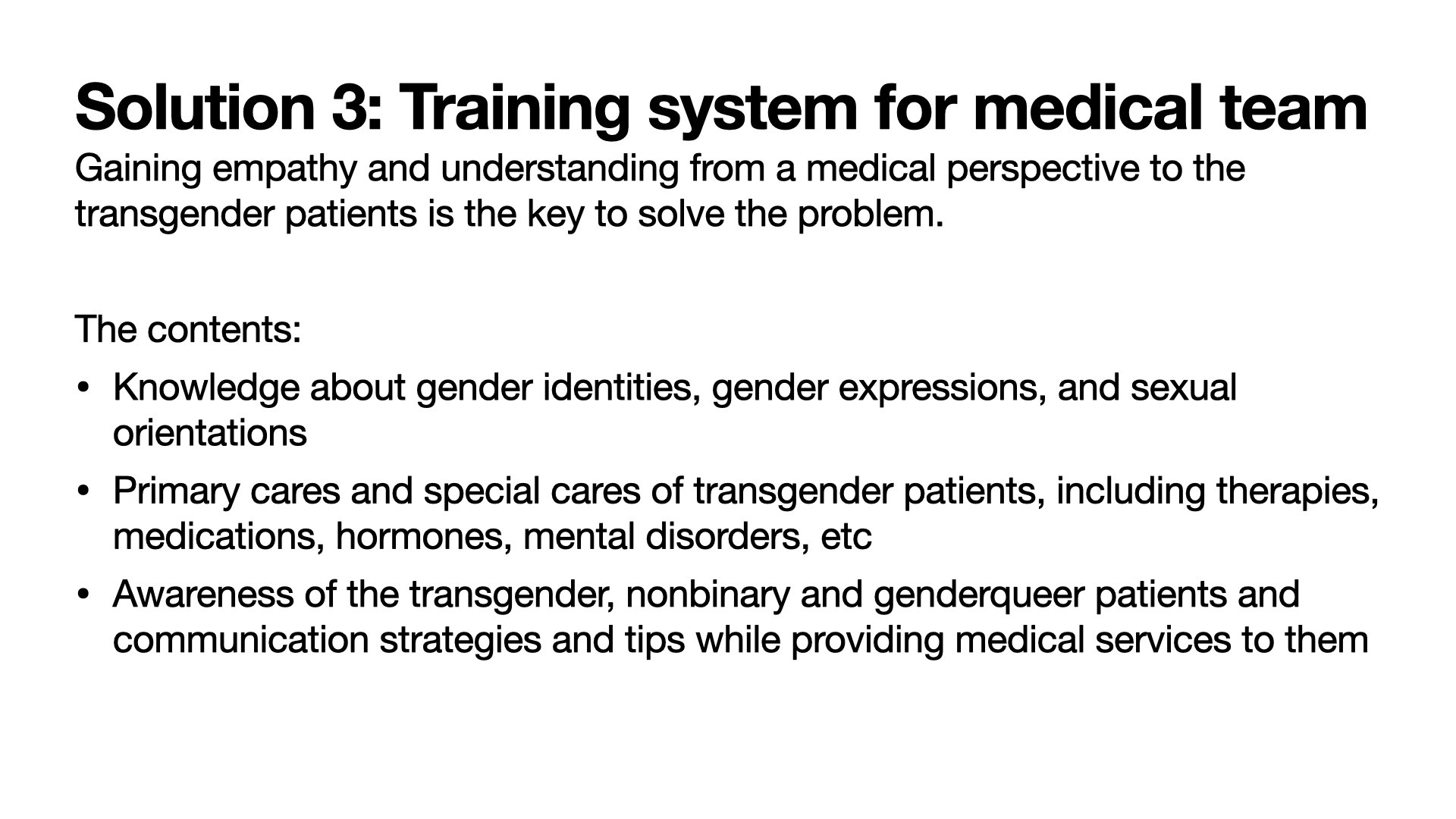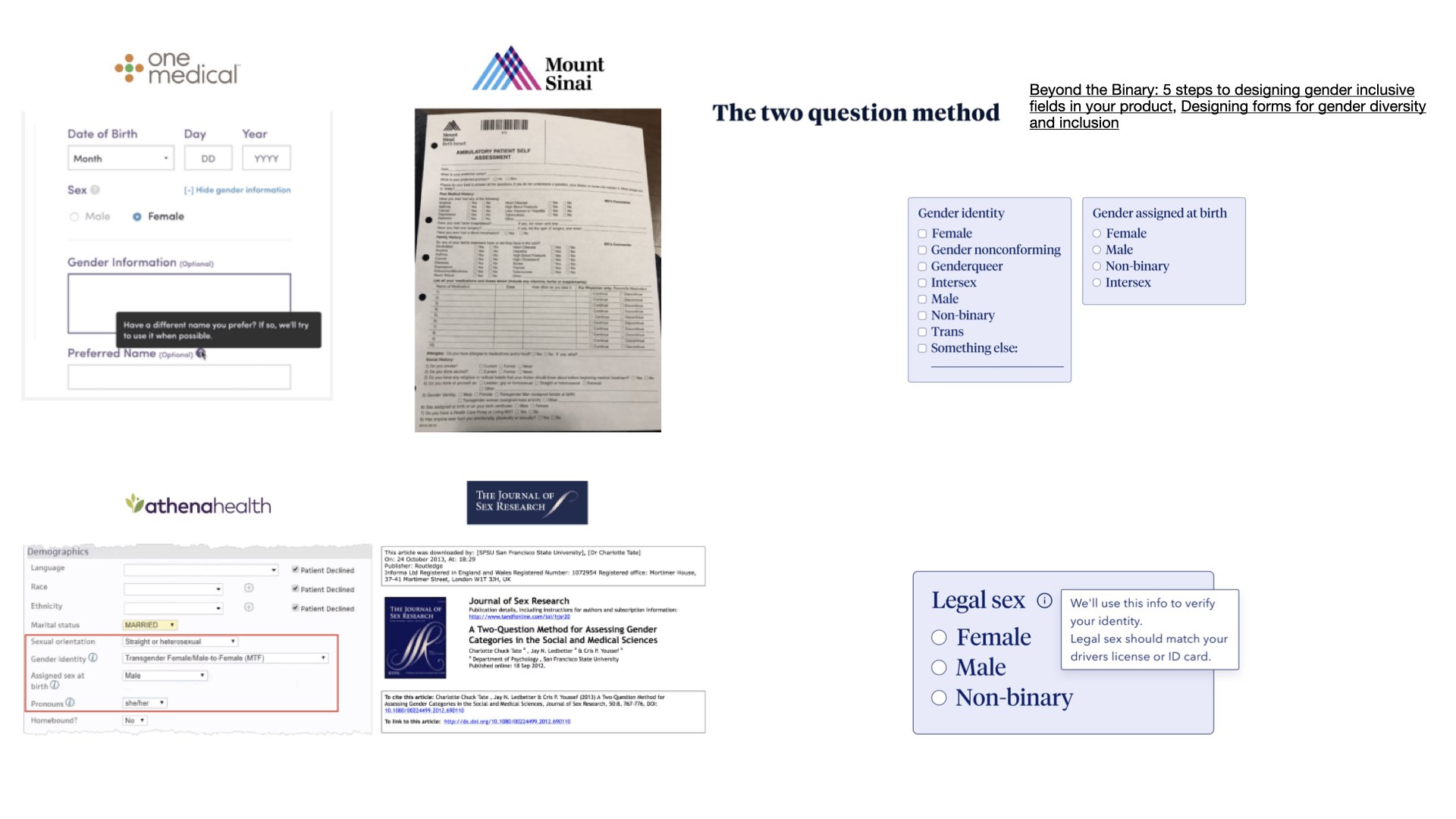
Transgender Health Experience at NYU Langone Health
A revamping design project for improving transgender patients’ medical experiences at NYU Langone Health.
This project is sponsored by the Innovation Lab at NYU Langone Health

Project introduction
Sexual and gender minorities (SGM) are among the most marginalized and underserved populations in the health system. Challenges in health care experienced by the SGM community include, but are not limited to stigma, structural barriers, and lack of experienced health care providers in caring for them. Our class partnered with NYU Langone’s FuturePractice team to work on potential design solutions to improve NYU Langone’s patient experience to be more inclusive, supportive and positive for people who are transgender, nonbinary and genderqueer.
Timeline: Nov. 2021 - Dec. 2021 (Six-week project)
Teammates: Three classmates from NYU School of Tandon
My role: UX researcher & Visual designer
Quantitative research
Chloe is a transgender woman and she hasn’t been to a dentist for 3-4 years because of her negative experiences in the past. Once she has a therapist who misgendered her to an entire room of people..the doctor never talked to Chloe, never looked at her into her eyes, and never apologize for the mistakes he made. Because of the trauma she had before, Chloe is trying to opt out of medical services as much as she can to protect her mental health.
Chloe is not alone. Sexual and gender minorities (SGM) are among the most marginalized and underserved populations in the health system. According to “Injustice at every turn: a report of the National Transgender Discrimination Survey”:
27% of trans people postponed necessary medical care when sick or injured; a third delayed preventive care, or did not seek it out at all
33% of trans people receiving health care in the past year reported mistreatment, harassment or other negative experiences.
Half of the transgender participants report feeling as though they need to teach their provider about their gender identity and its implications on their health
Chloe Flora, a transgender woman, talking about her horrifying medical experieces on an interview with The Oregonian
Root Problems
Bad medical experiences
The bad experiences the transgender people have encountered broke the trust in the medical services they should be enjoying. Misgendering, discriminations, and assumptions are something that really frustrates them on a daily basis. The insensitivity and the lack of knowledge from the medical providers is the key that makes this entire experience frustrating, anxious, and uncomfortable for a lot of transgender people, which they actually deserve equal medical services with extra care.
Forgoing routine care after trauma
The bad experiences of being misgendered, mistreatment and discrimination that happened to the transgender patients, many of them chose to not go to the clinic because of the mental stress and anxiety they suffer, just like Chloe. As a result of unwillingness in receiving medical care due to fear and anxiety, transgender people are suffering from a higher rate of stress and mental disorders, as well as poor physical health conditions compared to the rest of society.
Problem statement
Their horrible medical experiences lead to the broken of the patient-provider trust bond that the transgender patients do not feel comfortable and confident to seek out medical support.
Given the prompt from NYU Langone: “How might NYU Langone Health improve its patient experience to be more inclusive, supportive, and positive for people who are transgender, nonbinary and genderqueer,” our group decides to focus on rebuilding and recreating the trust bond between transgender patients and the medical providers so trans patients feel comfortable and supportive while seeking medical services.
[HOW MIGHT WE] present resources and information about transgender health at NYU Langone that allows providers to be more open, personable, trustworthy to the patients [SO THAT…] the patients feel comfortable and confident to seek the medical services without the fear of being abused or discriminated.
Brainstorming
Each member of the team came up with 3-4 ideas to solve the problem based on research. I personally identified three main touchpoints to rebuild the trust:
After comparing everyone’s ideas in our group, we found ourselves overlapping this idea of redesigning NYU Langone’s existing transgender health page into a more accessible, personable and reliable website for the patients as a helpful aid when they are doing medical research. Here are some major flaws we as a team identified on the current trans health page:
Scattered and hidden resources across different websites under NYU Langone
Not enough information about doctors:
No personal attachment, reviews
No history of LGBTQ patients’ experiences/stories
Unclear navigation and lack of visual cues add a lot of cognitive burden to users
Personae
Design Approach
Given the time constraints of this project, our group landed on a design solution to revamp the current Transgender Health page on NYU Langone into a more transparent, resourceful and supportive user experience for transgender patients for the feasibility and practicality of this idea to be quickly implemented in a timely manner.
Reconstruction and redesign of the existing information presentation and architecture
Installation of new features that connect the doctors and the patients on transgender health
User research
We invited two interviewees who identify themselves as gender non-binary to participate in our user research. We aimed to get some real experiences and insights from the interviewees about their medical experiences and how exactly they utilize the online resources available on the medical services/facilities they choose to go by asking questions:
What are your current experiences with healthcare?
How do you seek/search medical services?
What are the factors you look for?
What are the current medical problems you face?
How important is mental/psychological care/resources and do you feel like you have access to that currently?
Some key User research findings
Word of mouth and online research are the primary ways to seek for medical information and help
They are looking for doctors who really understand transgender patients and can advocate for them
Still have the problem of lack of access to mental health treatments
Not enough resources to find communities, support systems, and good doctors
Group in-depth Zoom interview session
Participants. Due to privacy concerns, we blurred out their faces and names.
Pain points and solutions
Pain point #1: Hard to find good doctors online when they don’t have enough resources
Solution: More resources on NYU Website:
Reviews by other trans patients
System to let patients know if the doctor’s office is LGBTQ+ friendly
Personal videos on doctors’ profiles explaining their effort/what they advocate for
Integrate resources NYU offers into the Transgender Health page
Pain point #2: Despite the importance of mental health care for transgender patients, there is not enough focus on it on the Transgender Health page
Solution: More mental health support:
Create a tab for mental care at Transgender Health
News and resources of mental care for transgender patients
Sharing patient stories
Prototype and rationales
Our solution focuses on revamping the following pages of the transgender health program website on NYU Langone (The parts I worked on are bolded):
Home page
Doctor’s page and doctor’s profile page
Our care team
Mental support resource hub
At the same time, our group found this article of sharing tactics of building trust for the business very insightful in supporting our solutions in a theoretical way. By applying and connecting the tactics mentioned in this article, we are able to provide a set of solutions to recreate the trust bond between transgender patients and medical providers in a convincing way.
Home page
Trust-building Tactics: Show the good intentions of why the business is doing what it is doing right now.
Our solution and fixes: Clear navigation of the website for the patients to quickly scan and decide what and where to go for their goals
Positioning of “Our Team of Doctors”
Contact Section
Trans/LGBQT+ safe Badges
Doctor’s page and profile page
Trust-building Tactics: Clear communication - be clear about the business and authentic
Our solution and fixes: Reconstructing the information presentations and structures to provide multiple aspects of the information in a more flexible and personable way.
Clinic environment
Doctors/provider’s information
Appointment and scheduling
Our care team
Trust-building Tactics: Clear communication - be clear about the business and authentic
Our solution and fixes: Reconstructing the information
Available services
Doctors/provider’s information
Mental health resources hub
Trust-building Tactics:
The law of giving: information, knowledge, inspiration or resources
The social proof: setting video or written testimonials or reviews
Our solution and fixes: provide a resources hub for transgender patients that could work as a reference and mental support when they need help.
Create and re-collect all the available resources, news, research studies within the
NYU Langone web locationsRe-collect patients’ experiences & stories
Presentation
Our group presented the solution and prototype we created to the NYU Langone sponsors and the entire class with stories, data, user research and rationales as a group during the last class of the semester on December 14, 2021. Four of us took turns to talk about the design process we as a group have gone through and how we would like to plan for the next iteration since design is an iterative process.
Please feel free to read my process blog for this project.
Our group presentation
Special thanks to my teammates
My takeaways
Transgender and medical experiences are topics that I have no experience and knowledge about before working on this project. It is extremely challenging to find the users to me personally because I have no personal connections but also given the sensitivity of the trans population and medical information logistically. However, by working with my teammates, we were able to conquer the challenge and follow the design process as we planned. Even though we had to rush to finish the project only in 5 weeks, the project was praised as research-supported and technically feasible by the stakeholders at NYU Langone's Innovation Lab. Our project was selected by our sponsor to be featured in the Innovation Lab (coming soon!)























